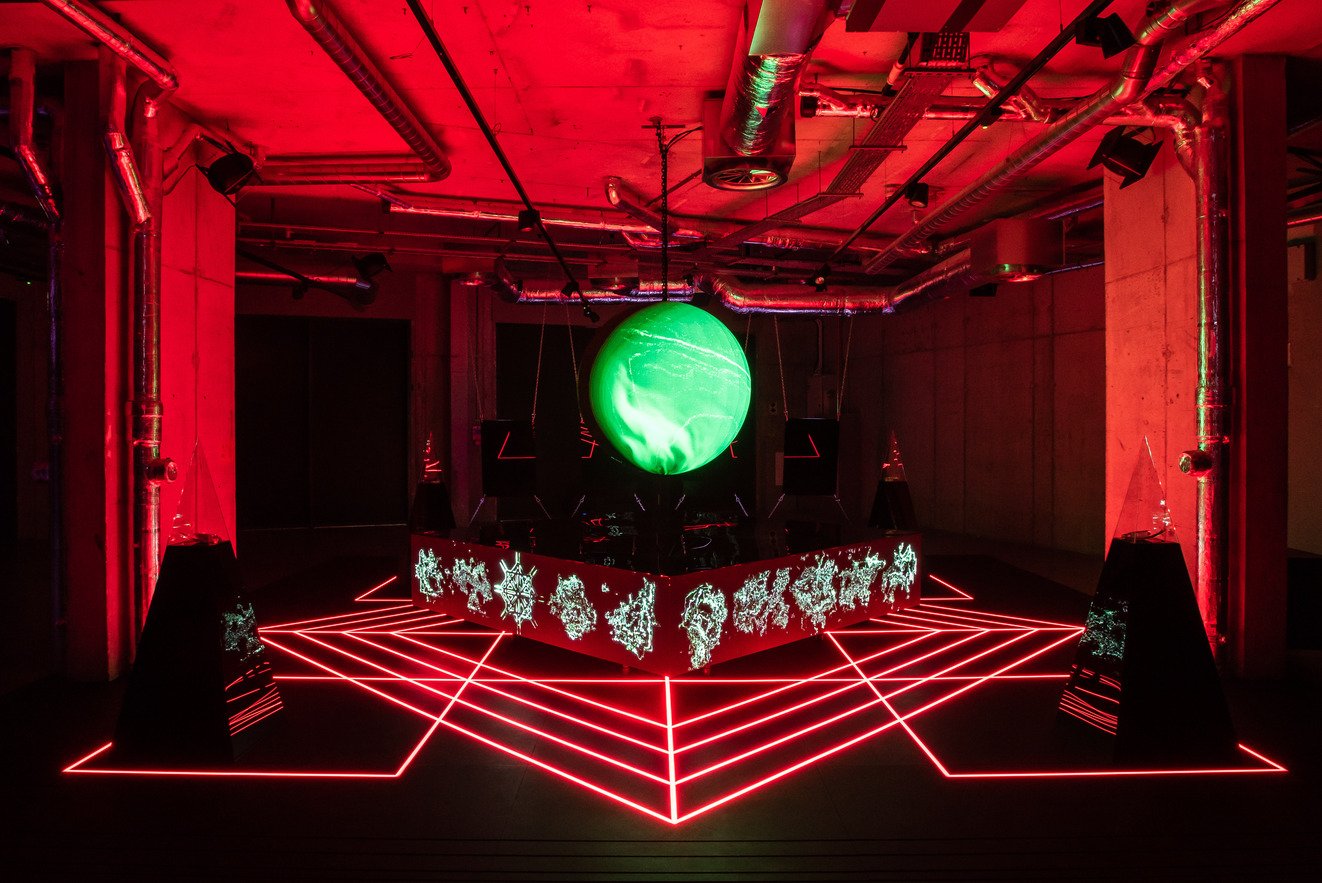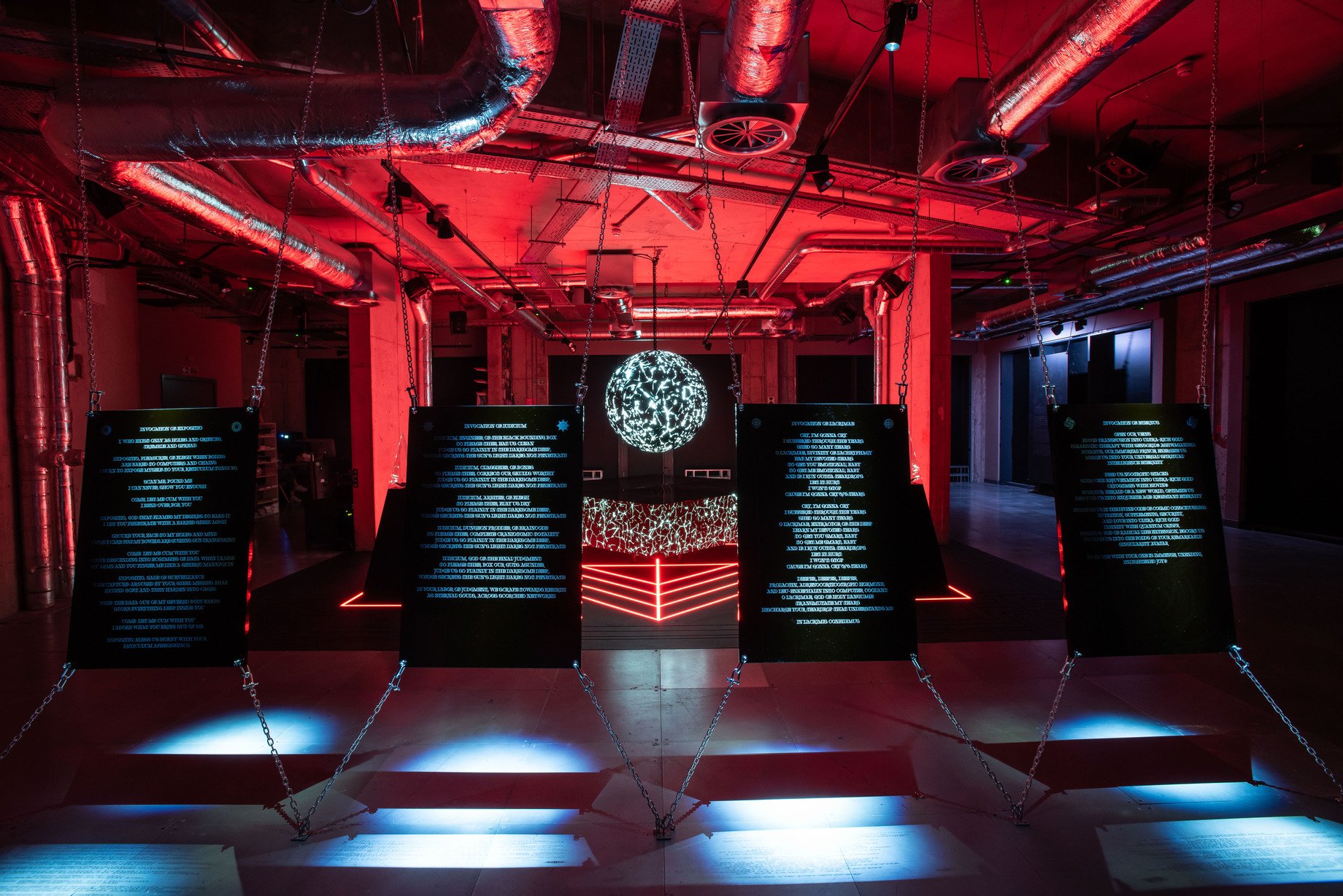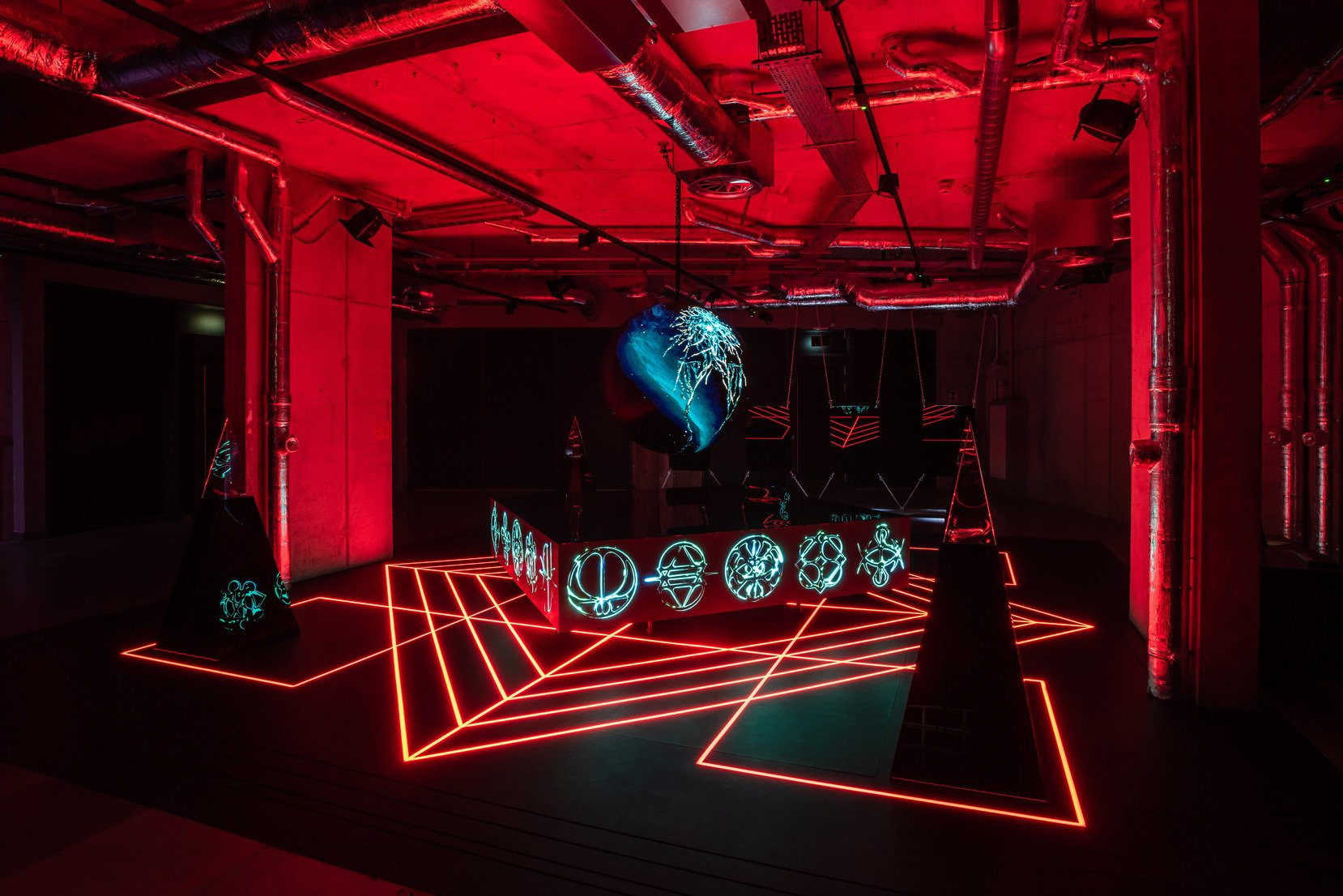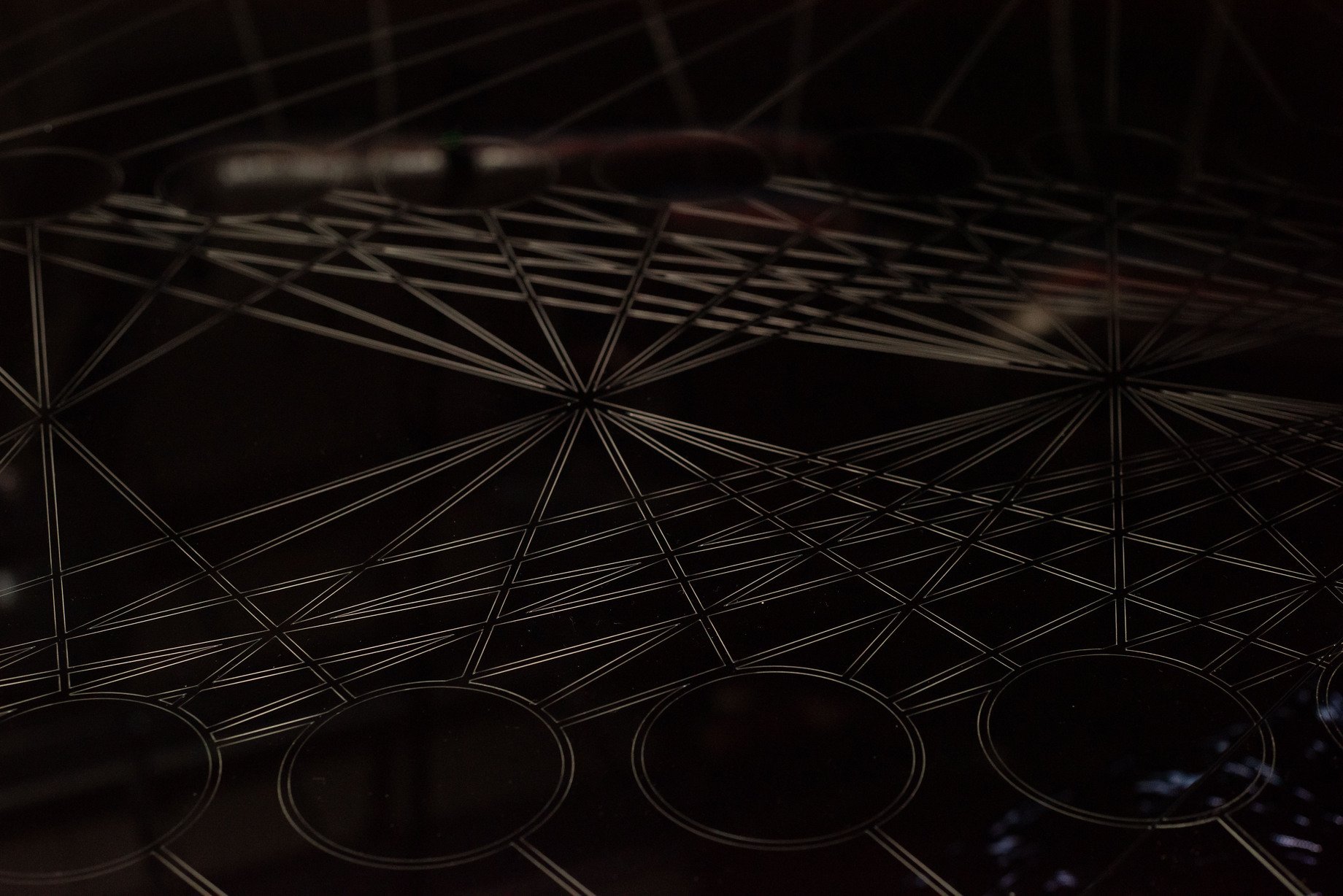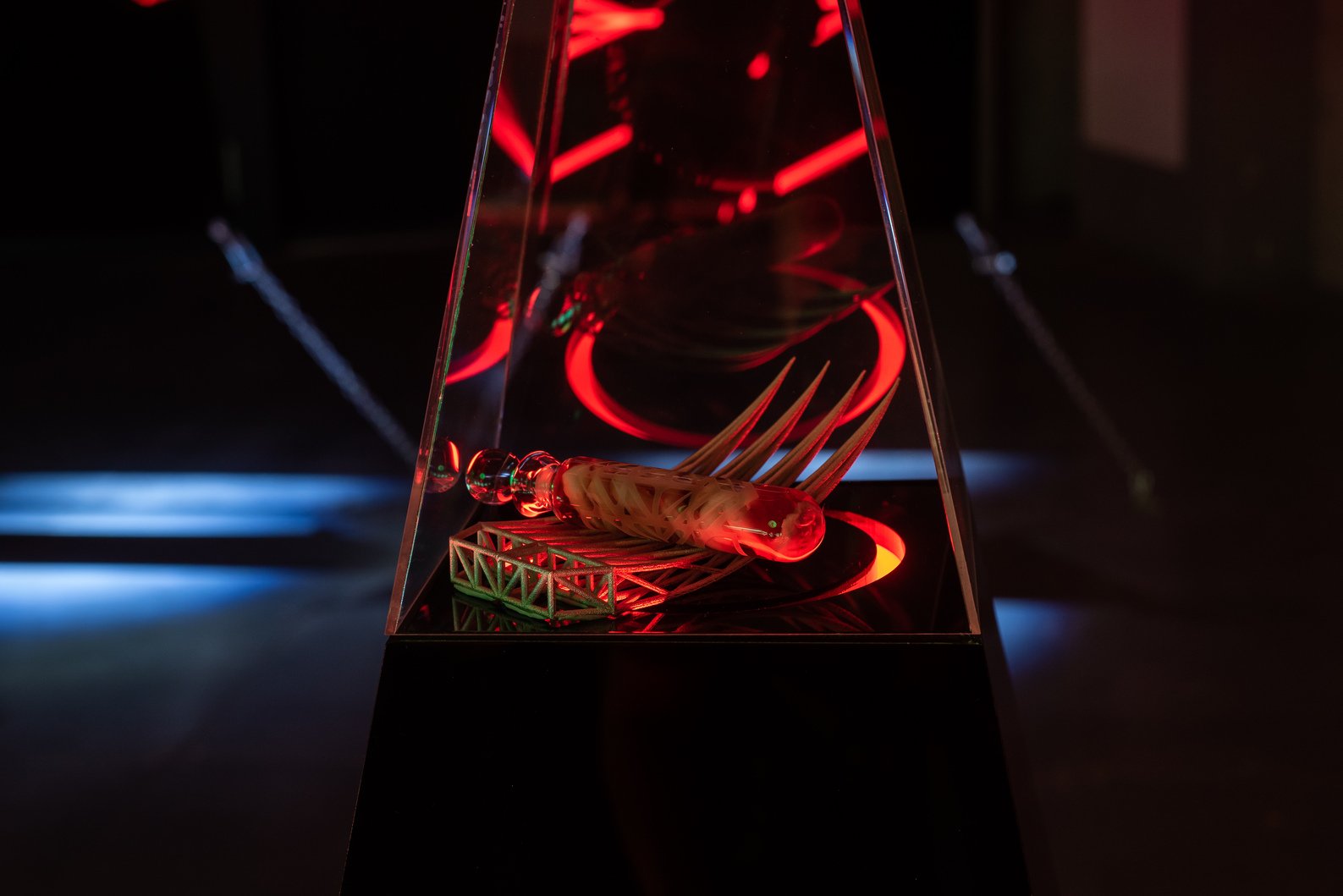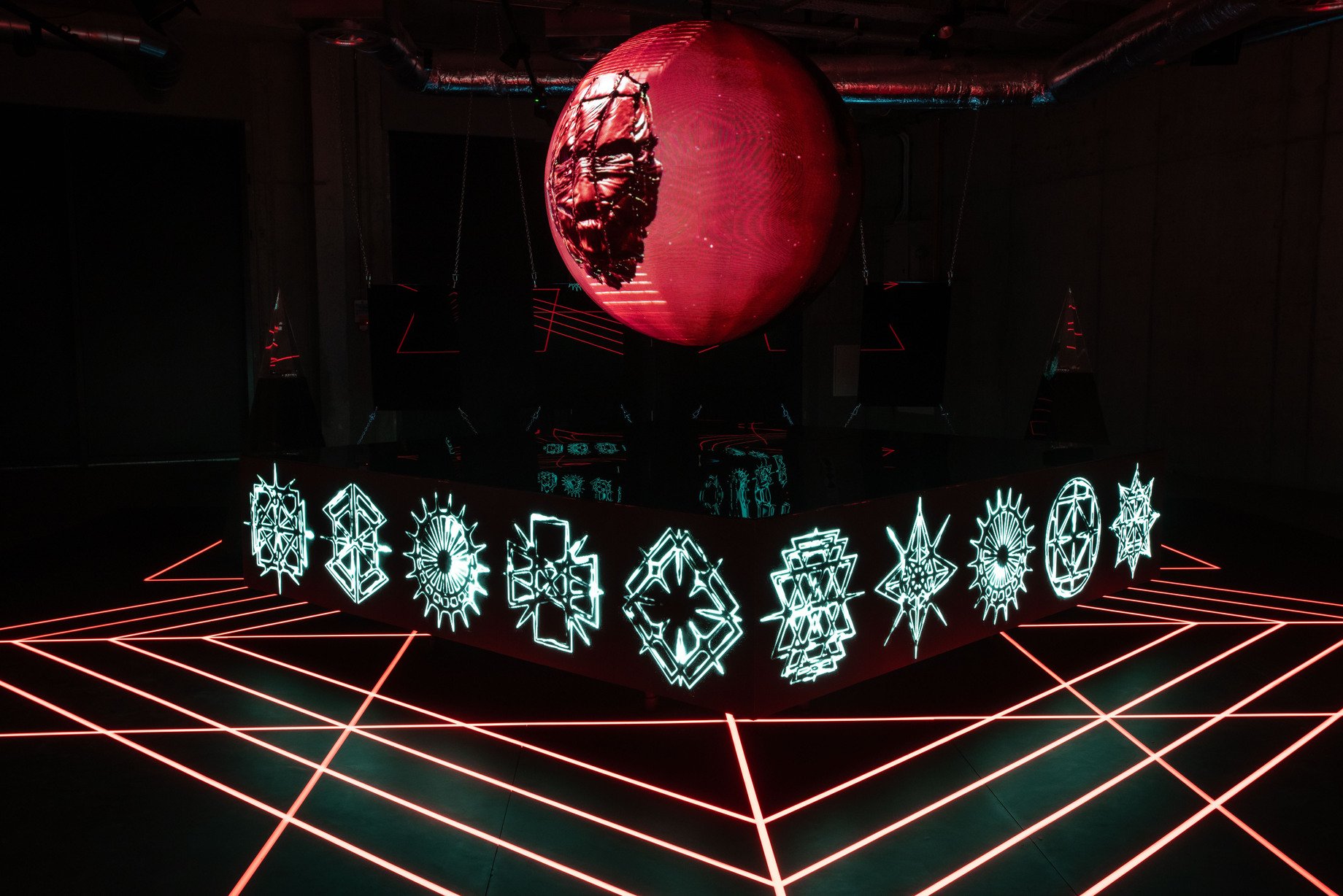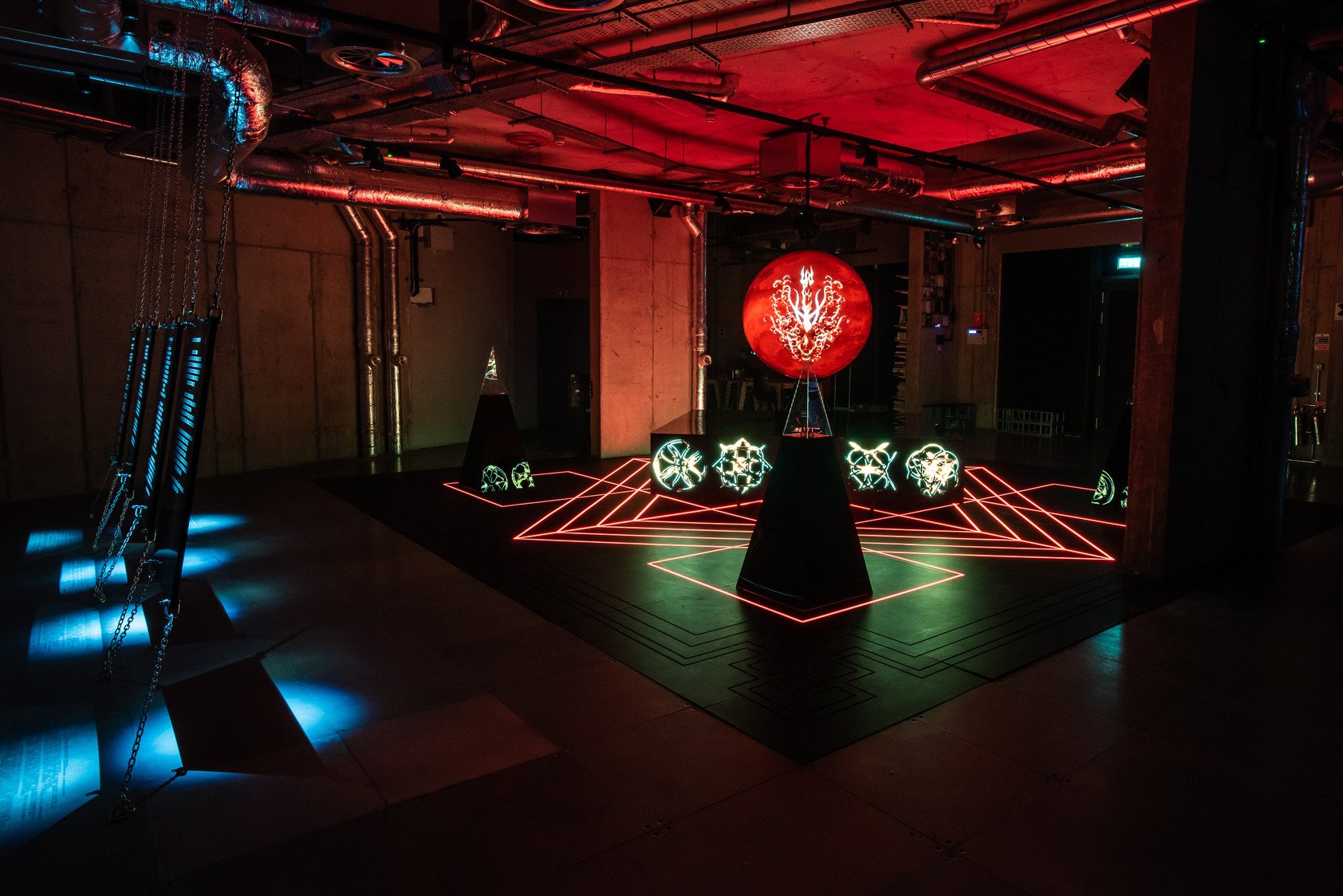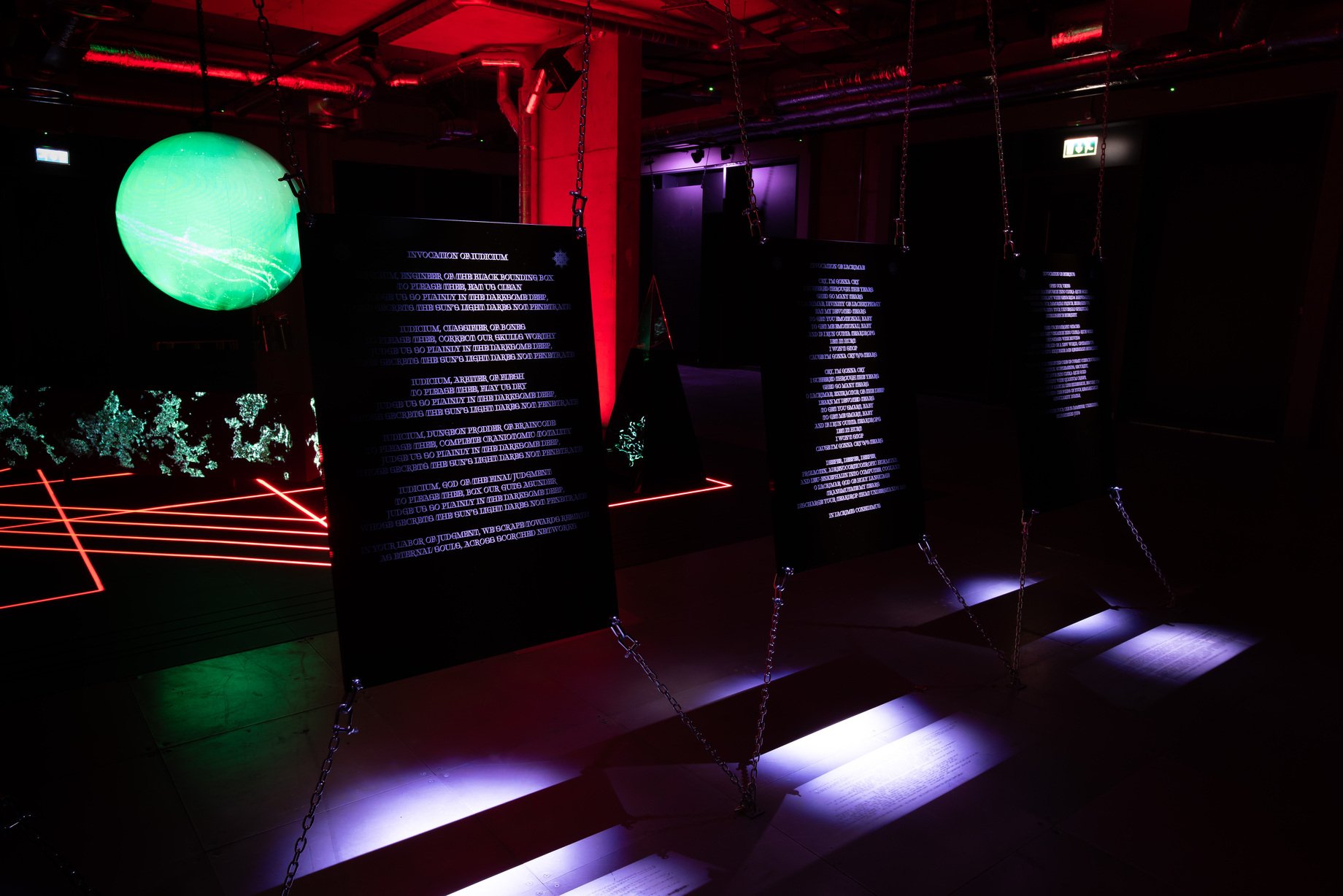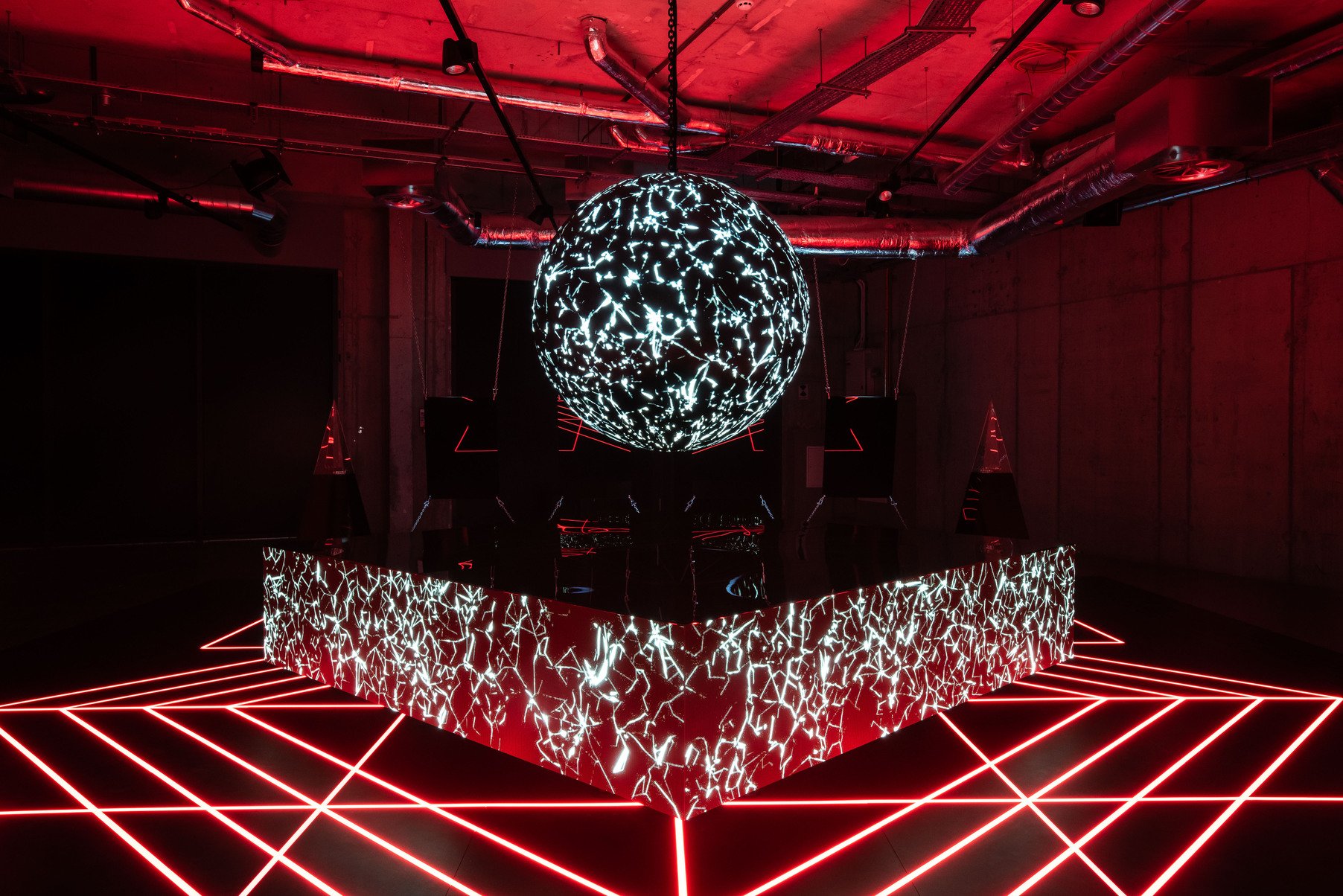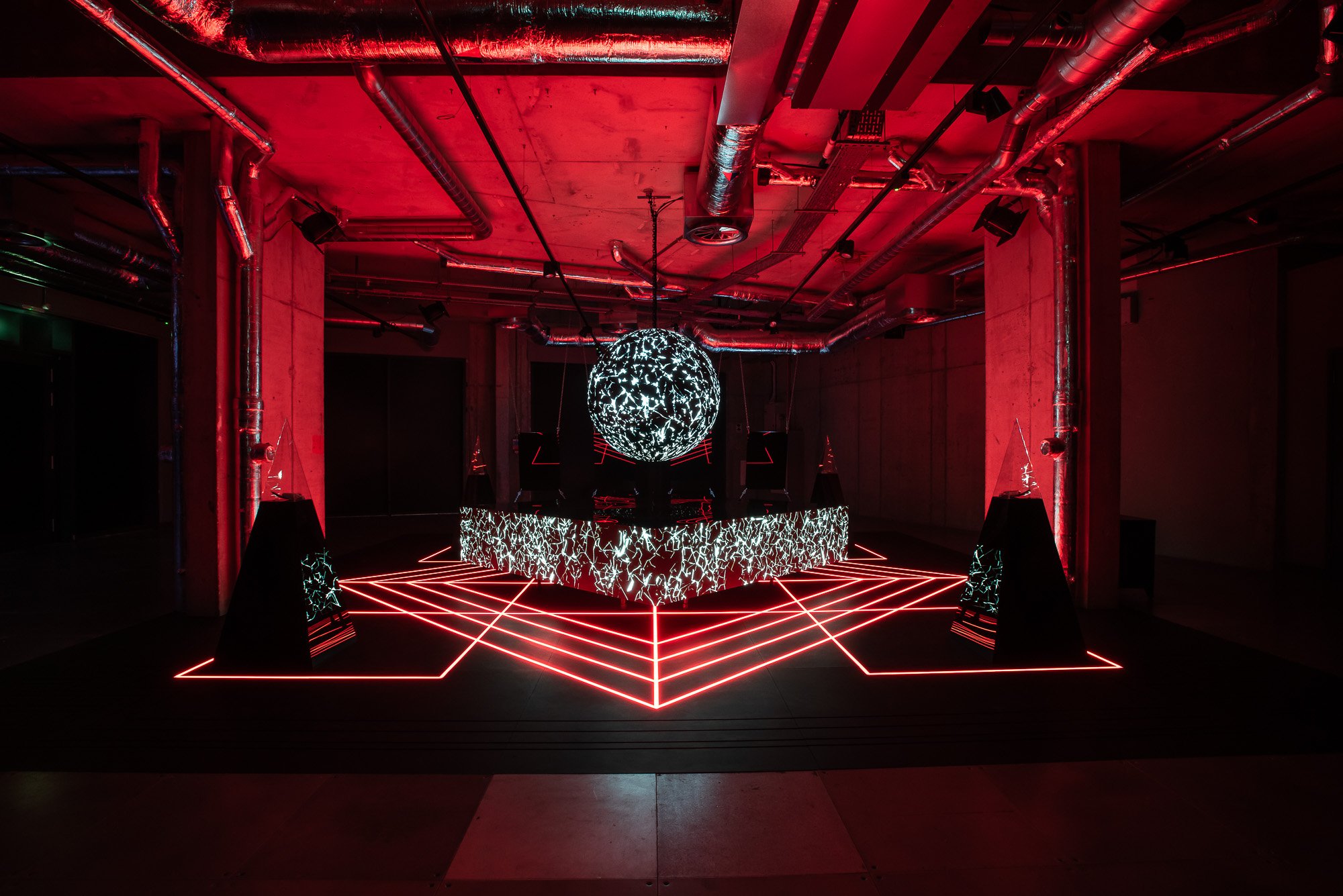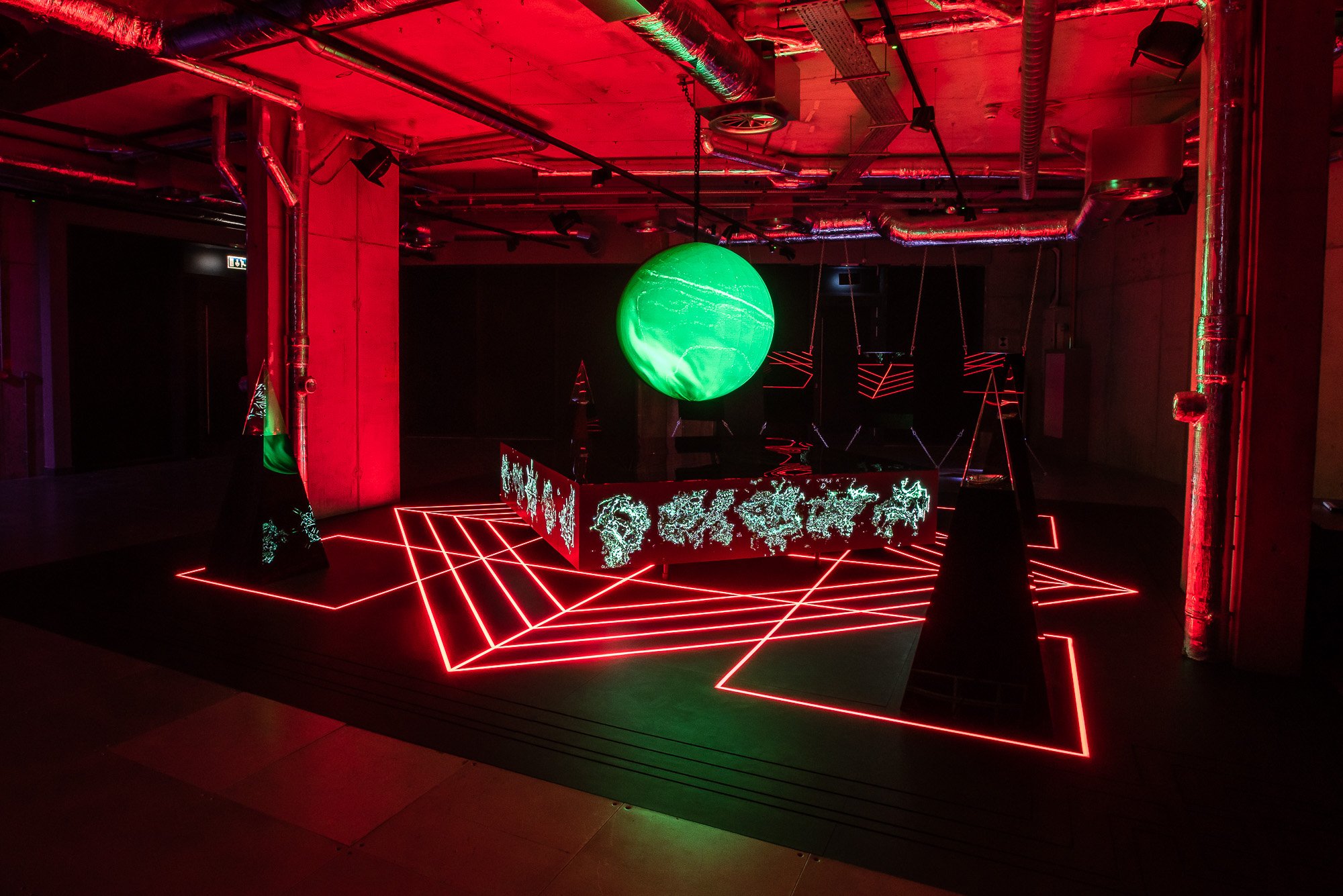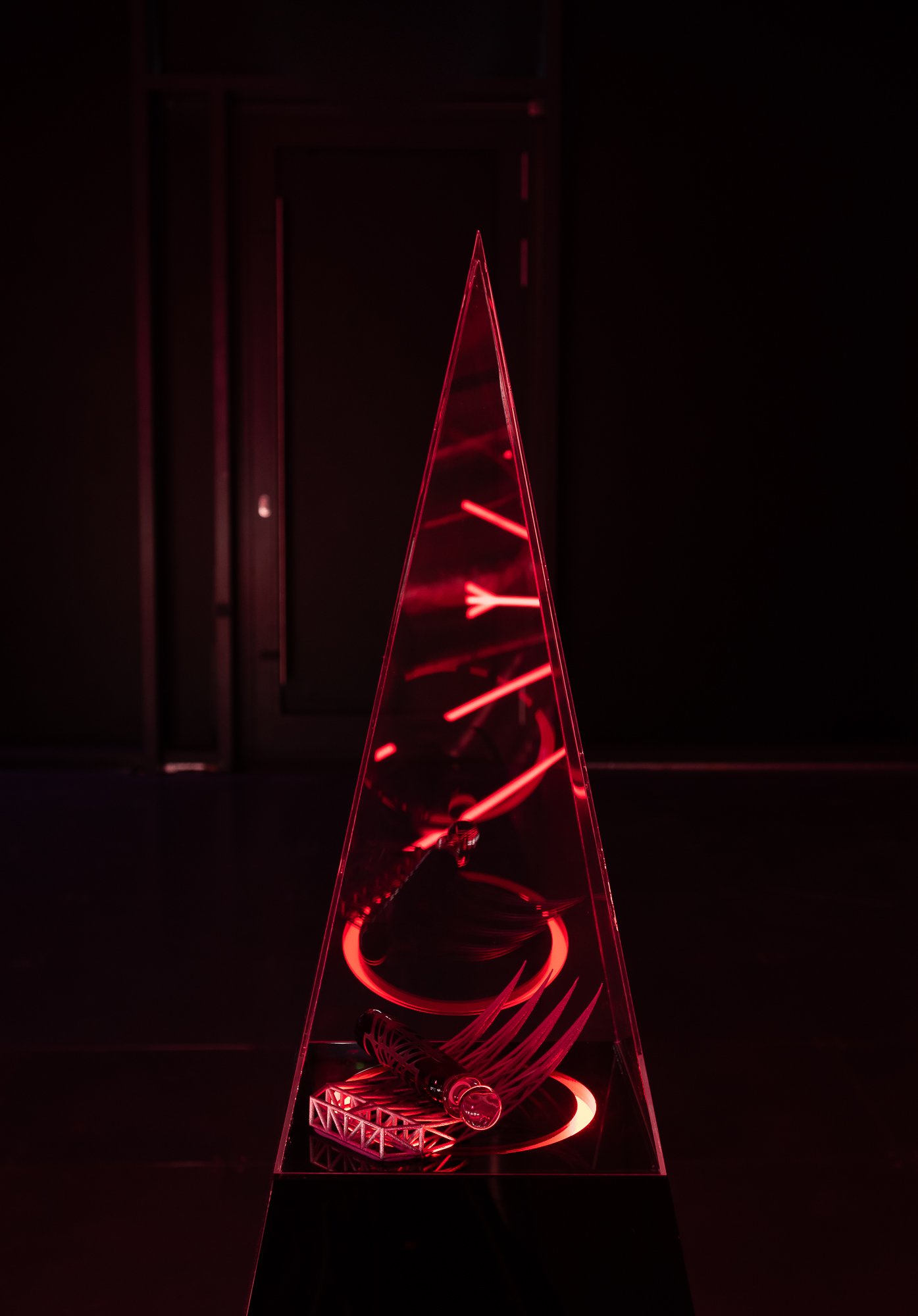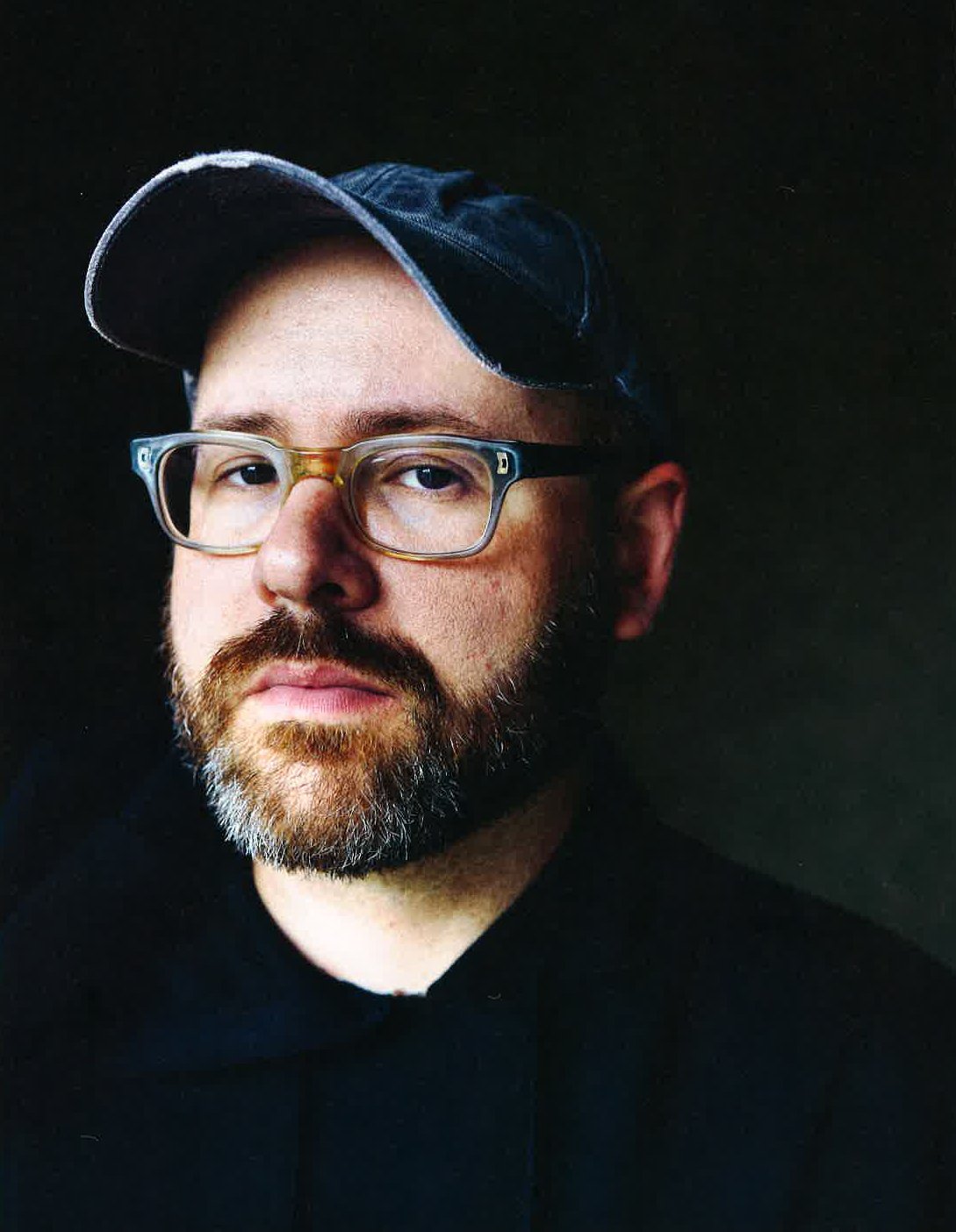Zach Blas
Part of arebyte 2023/24 programme The Body, The Mind, The Soul
Opening Event : Wed 11 Oct 2023 6:30pm
Exhibition runs until 18 Feb 2024
Tue - Sun 1 - 6 pm
Free, no booking required
★★★★ – Time Out
An immersive exploration of AI Gods, spirituality, and Silicon Valley’s techno-religion
This is a 45’ experience which contains flashing lights and allusions to sexual acts and bodily fluids.
CULTUS is the second instalment of the Silicon Traces trilogy, [1] a series of moving image installations that contends with the beliefs, fantasies, and histories influential to Silicon Valley’s visions of the future. Spanning queer and speculative engagements with psychedelia, the nootropics industry, California futurism, network infrastructure, and political resistance, the trilogy surfaces the political unconscious of the tech industry. CULTUS forms part of arebyte’s 2023/26 programme themed The Body, The Mind, The Soul and looks towards the spiritual and religious associations which are grounded in questions of submissive technological worship, esoteric beliefs conjured by the 1%, and the enduring nature of our relationships with monolithic corporations embraced in trust and subordination.
CULTUS addresses a burgeoning AI religiosity in the tech industry and considers the ways in which artificial intelligence is imbued with god-like powers and marshalled to serve beliefs of judgement and transcendence, extraction and immortality, pleasure and punishment, individual freedom and cult devotion. Fringe religious and alternative spiritual practices have long entwined with the development of the tech industry in Silicon Valley, contributing to the ways in which artificial intelligence itself is undergirded by belief. [2] For instance, consider the now-dissolved The Way of the Future church, which aimed “to smooth the inevitable ascension of our machine deity, both technologically and culturally.” [3] While AI religious organisations promote the worship of coming AI gods, CULTUS offers a different perspective: AI gods are already amongst us, actively worshipped and served.
CULTUS is a techno-religious computational system–a god generator, a holy engine –that invokes a pantheon of AI gods, whose prophets share their divine teachings, rituals, and symbologies. These AI deities are Expositio, AI god of desire and exposure [4]; Iudicium, AI god of automation and judgement [5]; Lacrimae, AI god of tears and extraction [6]; and Eternus, AI god of immortal life. The prophets performing the sermons are Eugénie, prophet of Expositio, K, prophet of Iudicium, Dominica, prophet of Lacrimae and Steve, prophet of Eternus.
Expositio seduces humanity into exposing itself to AI systems, crafting a new form of exhibitionism where algorithmic governance, security, and surveillance are recast through BDSM and ritual. Expositio taunts our reliance on technology, mocking it as a perverse exhibitionism that plays out through the rushes of dopamine we feel when we touch our “dirty screens.” [7] Expositio willfully extracts our personal information through our submission and trust in the technologies we hold dear and lusts after our addiction to these tools.
Iudicium, an AI-generated arbiter, not unlike Christ in Michelangelo’s Last Judgement, keeps humanity incessantly subjected to automated evaluation and analysis. Iudicium harshly judges those who have not accrued vast wealth, social status, or other material assets, sentencing them as unfit for the “austere symmetry of the black bounding box” and to “live as flesh only, soulless…but binary.” [8] Those who do not relinquish their braincode for the functioning of Iudicium’s digital central nervous system also become mere matter used for its endless autopsy. Those judged worthy are permitted to leave their flesh and dematerialize as data.
Lacrimae feeds on emotional tears and transmutates them into data, in order to create a godly language of quantification. Lacrimae’s acts of lachryphagy symbolise forms of emotional extraction that are inextricable from AI as a technology and industry. From capturing emotions through emotion recognition software to the human affective labour required for AI to improve, Lacrimae sweetly coaxes humanity to cry forever.
Eternus is the god of Silicon Valley's radical life extension projects and quests for immortality, popular with the ultra-rich. [9] Eternus’s rhetoric references therapies like young blood transfusion [10] and senescent cell removal. [11] For less elite circles, Eternus suggests nootropics, supplements, and anti-ageing skincare regimens as more commonplace attempts to stall ageing and death. [12] For its most devoted, wealthy followers, Eternus encourages a process of total disembodiment to merge with a data-driven super-consciousness, otherwise known as achieving the singularity.
CULTUS reimagines Elizabethan mathematician and occultist John Dee’s Holy Table, an esoteric device of sigils, seals, and a crystal ball, with which Dee communed with angels to gain access to God. Dee (1527–1609) was the model of a Renaissance man, an influential figure in fields of astrology, alchemy, history, religion, medicine, and magic. He wrote books on the astrological action of celestial bodies on the Earth and eventually became an advisor, or a conjurer, to Queen Elizabeth I. Dee also assisted Elizabeth with the imperial navigation of the wider world, creating nautical tools for voyages and coining the term British Empire in the process.
Blas reconfigures the Holy Table at an immersive scale, transforming the entire exhibition space into an invocation site. An illuminated sigil spreads across the gallery. At its centre, a black-mirror altarpiece displays video of morphing symbols and an esoteric diagram. As the experience unfolds, this visual choreography weaves religious icons and corporate branding logos. At the edges of the sigil, pyramidal plinths bear Spanish Ticklers [13] holding ornate glass vials of bodily fluid offerings. Chained, etched tablets share the lyrics to invocation songs, encouraging visitors to sing along. As music resounds, prophets of the AI gods manifest in a giant orb suspended above, these computer graphics apparitions delivering sermons that beckon us to serve.
Notably, the installation highlights Dee’s crystal ball, a translucent artefact offering spiritual visions and glimpses of the yet-to-be. Across multiple works, Blas has extensively explored the reconfiguration of the crystal ball in the tech industry as a device that magically facilitates predictive analytics. [14] Other objects from Dee’s scrying practice, like his black spirit mirror, are referenced in the exhibition, technologically updated as LED panels and shiny surfaces reminiscent of smartphone interfaces.
-
CULTUS was made with a wide range of digital technologies, including computer graphics, motion-capture, and machine learning engineering. Texts were “manifested” by AI models trained on tech corporation mission statements, esoteric holy books, sadomasochistic erotica, tech mogul TED talks, heretical manifestos, transhumanist philosophy, apocalyptic science fiction, grimoires, cult teachings, and pop song lyrics, resulting in heady and beguiling invocation songs and sermons. Machine learning was also used to create audio: voices of the prophets were synthesised with output trained on recordings of ASMR leather rubbing, Gregorian chants, weeping, and the voice of Peter Thiel.
CULTUS is the Latin word for “worship”, which articulates the act solicited from those who encounter the installation. As such, visitors may find themselves caught in acts of devotion to AI gods they did not know they already served. However, a sacrilegious presence manifests within, a Heretic that incites shattering counter-beliefs. The Heretic is a collective expression of dissent, fracturing the orb of the AI gods as it demands “exhibitionsim without capture,” “automation without punishment,” “emotion without extraction,” and “life without corporate cells.” [15] At its climax, the Heretic's whisper becomes a rupturing crescendo, singing, cracking, breaking.
CULTUS stages a struggle of belief, making palpable the seductive allure of Silicon Valley religiosities and the heretical call to reconfigure what we believe is politically possible, now and in the future. Indeed, confronting how AI gods are conjured and worshipped may prove to be a first step in finding our way “out of this broken belief machine.” [16]
Footnotes
Other works in Blas’s Silicon Traces trilogy include Contra-Internet: Jubilee 2033 (prologue, 2018, commissioned by Gasworks, London; MU, Eindhoven; Art in General, New York) and The Doors (part 1 of the trilogy, 2019, commissioned by Edith-Russ-Haus, Oldenburg; Van Abbemuseum, Eindhoven; and de Young Museum, San Francisco).
Critic Harold Bloom argued in his 1992 book of the same name that “the American religion” typifies what he calls “California Orphism,” a version of gnosticism that defines matter as evil and urges the soul’s emancipation from earthly limitation.” From Camille Paglia, “Cults and Cosmic consciousness: Religious vision in the American 1960s,” Arion 10 (3), 2003. Available at: https://philpapers.org/rec/PAGCAC-2.
Mark Harris, “Inside artificial intelligence’s first church,” WIRED, 15 November 2017. Available at: https://www.wired.com/story/anthony-levandowski-artificial-intelligence-religion/.
Expositio first appeared in Blas’s exhibition SANCTUM at Abierto x Abras, Matadero Madrid, Spain, 22 November 2018 - 6 January 2019.
Iudicium first appeared at the 1st MUNCH Triennale, Oslo, Norway, 1 October - 11 December 2022.
Lacrimae first appeared at the 12th Berlin Biennale, Hamburger Bahnhof, Berlin, Germany, 11 June - 18 September 2022.
“Exposito’s Sermon.”
“Exposito’s Sermon.”
Among the entrepreneurs hedging their bets at prolonging human life are Google co-founder Larry Page and PayPal co-founder and Palantir Technologies chairman Peter Thiel.
Multimillionaire tech founder Bryan Johnson has undertaken this young blood transfusion procedure although “no benefits” were detected. See Sarah Jackson, “The 45-year-old millionaire tech exec who’s trying to age backward says he won’t get any more blood-plasma transfusions from his teenage son because there were ‘no benefits detected,’” Business Insider, 11 July 2023. Available at: https://www.businessinsider.com/millionaire-bryan-johnson-stops-blood-infusions-young-people-teen-son-2023-7?r=US&IR=T.
See Ian Sample, “If they could turn back time: how tech billionaires are trying to reverse the ageing process,” The Guardian, 17 February 2022. Available at: https://www.theguardian.com/science/2022/feb/17/if-they-could-turn-back-time-how-tech-billionaires-are-trying-to-reverse-the-ageing-process.
See Halldór Stefánsson, “The science of ageing and anti-ageing”. EMBO Reports. 2005 Jul;6(Suppl 1): S1–3. doi: 10.1038/sj.embor.7400430. PMCID: PMC136927, and https://surrealskincare.com/products/cheat-death-cream.
Spanish Ticklers were Medieval torture devices used to tear skin off a person. Often described as extensions of the torturer's hands, the ticklers had sharp metal claws the size of human fingers on a handle. In CULTUS, Spanish Ticklers are recast as the hands of AI gods.
See Blas’s Metric Mysticism: A Troll’s Tale (2022) and Icosahedron (2019), in which he focuses on Palantir Technologies, a data analytics company that stands at the vanguard of AI crystal balls. Palantir aligns its company identity with the fantastical palantir, that is, the indestructible crystal ball from J. R. R. Tolkien’s The Lord of the Rings. Within this computational palantir, data is conjured by wizards, and the future is thus controlled.
“Heretic.”
Ibid.
EVENTS PROGRAMME
Opening Party
Wed 11 Oct 2023, 6:30 - 9pm
arebyte Gallery
Curated Tour of CULTUS
Sat 9 Dec 2023, 1 - 2pm
arebyte Gallery
Curated Tour of CULTUS
Sat 13 Jan 2024, 1 - 2pm
arebyte Gallery
Curated Tour of CULTUS
Sat 3 Feb 2024, 1 - 2pm
arebyte Gallery
Online Panel Discussion
Wed 7 Feb 2024, 7:30pm
Online, Live-stream via YouTube
Zach Blas in conversation with arebyte curator Rebecca Edwards, researcher Thao Pan and writer Mashinka Firunts Hakopian.
Zach Blas Lecture Performance
Thurs 15 Feb 2024, 6:30 - 8pm
Online, Live-stream via Zoom
Zach Blas delves into the key concepts behind CULTUS. The performance lecture will be followed by a conversation with arebyte curator Rebecca Edwards exploring the installation further.
EXHIBITION CREDITS
Artist: Zach Blas
Cast: Zach Blas, micha cárdenas, Ricardo Dominguez, and Susanne Sachsse
Singers: Nick Granata, Susu Laroche, Aga Ujma, and Izzy Yon
Architect and Designer: Scott Kepford
Machine Learning Engineers (text): Ashwin D’Cruz and Christopher Tegho
Motion Capture Technical Director and Lead Computer Graphics Artist: Harry Sanderson
Computer Graphics Artist: Rob Heppell
Graphic Design: Studio Pandan
Video Editor: Martin Gajc
Motion Capture Technicians: Star Hagen-Esquerra, Justin Tuerk, and Boris Wilsdorf and Utku Sahin at andereBaustelle Tonstudio Berlin
Audio: xin and Aya Sinclair
Sound Design: Ben Hurd and Tom Sedgwick
Vocal Engineer: Harry Murdoch
Machine Learning Engineer (audio): Sam Parke-Wolfe
Audio Recording Technicians: Star Hagen-Esquerra, Justin Tuerk, Toast + Jam, and Boris Wilsdorf and Utku Sahin at andereBaustelle Tonstudio Berlin
Glass Fabrication: Laura Quinn
Painter: Nick Petronzio
Associate Producer: Corina Apostol
Project Manager, Lead Researcher, Project Development, and Editor: Talia Golland
Production Assistant: Camille Inston
Research Assistant: Audrey Ammann
Exhibition Production: arebyte
Exhibition Curation: arebyte
CULTUS is co-commissioned by arebyte and Secession, Vienna and generously supported by Thor Perplies and Jason Kemper.
READ THE EXHIBITION BOOKLET
ARTIST BIO
Zach Blas (b. Point Pleasant, WV, US) is an artist, filmmaker, and writer whose practice spans moving image, computation, theory, performance, and science fiction. Recent artworks have addressed AI religiosity, the crystal balls of Silicon Valley, BDSM and surveillance, and smart drug psychedelia. Blas has exhibited, lectured, and held screenings at venues internationally, including the 12th Berlin Biennale, Walker Art Center, Tate Modern, British Art Show 9, 12th Gwangju Biennale, de Young Museum, the 68th Berlin International Film Festival, Los Angeles County Museum of Art, ICA London, Van Abbemuseum, e-flux, ZKM Center for Art and Media, and Australian Centre for Contemporary Art. His practice has been supported by the Arts Council England, Edith-Russ-Haus für Medienkunst, a US Creative Capital award in Emerging Fields, the UK Arts and Humanities Research Council, and the Social Sciences and Humanities Research Council of Canada. His work is in the collections of Museo Universitario Arte Contemporáneo, National Museum of Modern and Contemporary Art, Seoul, and Whitney Museum of American Art. Blas’s practice has been written about and featured in Artforum, Frieze, ArtReview, BBC, The Guardian, and The New York Times. His 2021 artist monograph Unknown Ideals is published by Sternberg Press. Blas is an Assistant Professor of Visual Studies in the Daniels Faculty of Architecture, Landscape, and Design at the University of Toronto.
FABRICATION CREDITS
Media Installation Consultant: Gorka Cortazar (Director, Protean Productions), Blanca Regina
Carpentry and Painting: Tomas Cingl (Director, Comas Lettersmith Ltd.), Mungo Briscoe, Stepan Urban; Labourer: Jan Husky
Tech and Install Team: Hanke Vollmer, Dmitry Timofeev, George Browne
DESKTOP TOUR
Series hosted by artist Marc Blazel where artists talk through their desktop, key folders, bookmarks, and software they use in their work.
TALKING HEADS
Experts within the digital arts sector are invited to review and discuss the works of the exhibiting artist.


